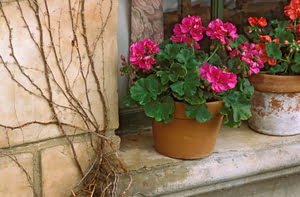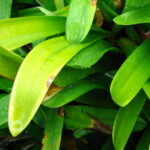Purchase your geraniums from reputable dealers. Isolate all new geraniums for at least two weeks before placing them among your other plants. Keep remedies on hand to check simple diseases and destroy pest if they appear. Remove spent flowers faded leaves. If a pest or disease attacks one of your geraniums, isolate the plant and scrub your hands before handling healthy plants.
Simple pesticides and precautionary dusts are good to have on hand in the event of trouble. Keep out of the reach of children and pets.
It is almost impossible for the average gardener to distinguish between these two diseases verticillium and stem rot, take every effort to keep plants in a healthy growing condition, keeping soil sterilized, and discarding all plants showing symptoms of disease.
Do not take cuttings from infected stock. The cutting may live for a short time but they are carriers of the disease and may spread it among your other geraniums. Verticillium is a soil fungus, which enters geraniums through their roots. It is often confused with bacterial rot and indeed many of the symptoms are similar. Verticillium infected plants show dwarfing, yellow leafing, which is brighter yellow than that of botrytis-infected plants, and wilt. Scented leaved cultivars rarely become wilted, but they do develop yellow spotted foliage. Older leaves on ivy-leaved geraniums lose color, turn gray-brown and still cling to the plant.
Bacterial Leaf Spot and Stem Rot:
Bacterial Leaf Rot caused by xanthomonas pelargoni. This bacterium attacks leaves and stems of plants, and cuttings. Leaf infection shows in round spots or large angular dead areas. Small water soaked spots on the undersides of leaves symphonize round leaf spot. In two or three days spots become slightly indented and the leaf wilts and dies. The disease may spread to leaves and stems or it may check itself, as many varieties are immune to the disease. This disease may manifest itself by killing an angular section on the leaf. Leaf edges wilt and in a week or two, the leaf dies and falls from the plant. Angular leaf killing is only one-step away from stem rot.
Stem Rot or Black Rot:
Stem rot is the scourge of geranium growers. Infected stems blacken and shrivel. If cut open these areas show a crumbly black rot. Black streaks along the stems show the presence of the bacteria in the vascular or water carrying system. As the disease progresses, plants suffer heavy damage and loss of foliage until, in advanced stages the only foliage remaining will be small leaves at branch tips. Bacteria infected cuttings slowly rot from the base upward and in two to four weeks the cuttings stems show the dull black brown or stem rot. The disease spread by knives, which have been contaminated in taking cuttings from infected plants, by handling plants and splashing water on plants. There is no known cure for this disease. Destroy plant and sterilize all tools, used on the infected plant
Other Leaf Spots:
Botrytis leaf, blossom-blight and gray mold also affect geraniums. Flower petals turn brown prematurely and drop onto the leaves. The leaf area under the dead blossoms becomes brown and moldy. Botrytis-infected leaves do not wilt and hang from the stem limply as in bacterial leaf spot. Botrytis usually effects older leaves first, and generally confines itself to a few leaves rather than spreading through the entire plant. Remove all dead leaves and flowers. The disease is more prevalent among plants growing in cold wet poorly ventilated areas. Raise the temperature, lower the humidity, provide better ventilation, and space plants so they do not crowd one another.
Virus Diseases:
Virus diseases appear more in winter than summer. There are no known cures. Foliage affected with mosaic virus becomes dotted with light and dark areas. Spreading through the entire plant and carried in cuttings. Leaf curl, also known as crinkle measles, symptoms include pale yellow spots, foliage crinkling and dwarfing with leaves finally yellowing and dropping. Marginal Leaf roll cupping and symptoms of curly top, a virus transmitted by the beet leafhopper per. Control virus diseases by propagating with disease free cutting from a mother block.
Cutting Rot:
Cutting rot, Symptoms are brown water soaked lesions ate the base of the cutting. Soon the area enlarges; turns black, and extends upward into the cutting. The affected area is often wet and slimy and the leaves yellow and fall from the cutting.
Pests:
Aphids, small black or green plant lice, appear on new growth. Use a household insecticide or dip tops of geraniums into soapy water.
Red Spider:
Red Spider is common in high temperature and low humidity. Red spider is so small it takes a magnifying glass to see them. The foliage will be yellow and brown. Get rid of red spider by spraying with household insecticide or cold water.
Mealy Bugs:
Mealy bugs look like specks of cotton. Touch each one with a cotton swab dipped in alcohol, nail polish remover or cologne. Use household insecticide
Caterpillars:
Caterpillars, Tobacco budworms, green or pinkish caterpillars that hatch from eggs laid by moths, damage flowers by boring into buds and dining on the tender petals. Dust with insecticide.
White Fly:
White fly, a very small white fly often group together on the underside of leaves, sapping strength and causing leaves to turn yellow and drop from the plant. Spray with insecticide
Nematodes:
Nematodes, or eelworms are not visible to the naked eye, yet they can do fatal damage to the geranium. They stunt the growth of the geraniums, showing in blisters on the plant leaves. Knock, the geranium free from the pot, examine the roots. The roots will have small nodules or swellings along the roots. Discard and burn infested plants. Do not use the soil. Scrub geranium pots with boiling water.





